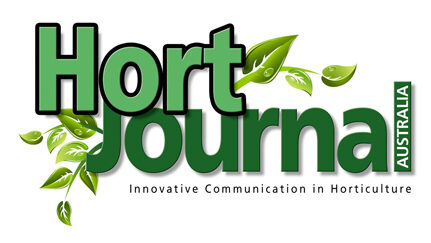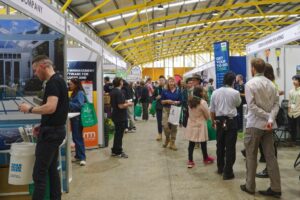
Out and about at the 2025 Landscape Expo
By Gabrielle Stannus
The Landscape Association held their Landscape Expo on Wednesday, 27 August 2025 in the Howie Pavilion at Sydney Showground. This was the first year that the expo was held at this bigger venue, and my first time attending. Here is my wrap-up of the landscapers, plants and products on display.
LANDSCAPERS
The landscape industry in Sydney is a little more diverse than that in my home state of Tasmania, as I found out speaking to the representatives of the many businesses exhibiting at the Expo. So, who did I meet and what type of landscaping are they doing?
Horticulturists on ropes
I met Nalan Deweert, Department Manager for Sky Gardens Group, who described his team to me as ‘horticulturists on ropes’, maintaining Sydney’s increasing green infrastructure. ‘We are not just rope technicians that have been subcontracted to work for landscapers. We are actually horticulturists.’ Nalan says that the cost to maintain green infrastructure can be extreme, so the Sky Gardens Group is moving away from a plant replacement model. They use Fytogreen’s FytoFelt to avoid slumpage issues associated with organic content in other green wall systems, thereby improving aeration and reducing pest and disease. ‘What we want to do is to put things on the wall, so they stay there and live, becoming a part of the infrastructure, Nalan said, ‘Whilst we are trying to reduce the maintenance cost, we are also trying to make sure that the installation is done well.’
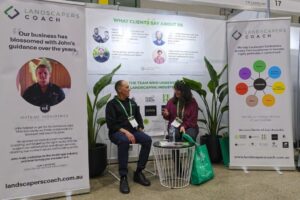
Speedy spaders
I also met some mass planting professionals who would put Speedy Gonzales to shame. I spoke with Nicholas Yard from Green Growth Planting, whose work covers civil and commercial construction and bush revegetation planting. Nicholas explained that the piece rate they pay to plant tube stock incentivises their workers, ‘Everything is on a piece rate, so every planter gets paid per plant. Other tasks like setting out the pots, that is all considered labour. We have a standard rate for those labour hours. Once planting starts, you start your count of your pots, plants and trays. You count at the end of the day, everyone collates their numbers, and we pay everyone based on a piece rate system. There is a good incentive to get fast, quick, and efficient, and have high quality work. There is good turnover for the client, but you get paid for the hard work that you do. An experienced planter can put in about 2,000 plants a day by themself. If the ground is nice and soft, then that number easily becomes 2,500 a day. Some planters can even plant 3,000 to 4,000 if they are really experienced and built for it.’ No wonder the Baller shovels this crew uses are also known as ‘speed spades’!
Water gardeners
I bumped into David Ting, a horticultural landscaper specialising in fishponds and water features, at the OASES stand, where he was helping to promote their water garden products, ‘I have been using OASES equipment for 25 years. I design all my own landscapes from small, self-contained water features to very large fishponds. So, I use a whole range of equipment depending on what is required, from small pumps for simple water features through to big, self-cleaning filters; I recently did one for 130,000 litres.’ Representing Hort Journal, I could not help but ask David where he sources his aquatic plants from. ‘Mostly I get them from a place called Wallis Creek Watergarden in the Hunter Valley,’ David told me, ‘They have lots of different kinds of water lilies, day bloomers, tropicals, night bloomers, temperates, lotus plants, irises, and a whole range of aquatic plants.’
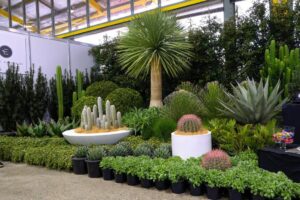
PLANTS
I also spoke with representatives of the various nurseries at the expo, for whom the landscaping industry makes up a large part of their business, about some of the new or newish plants they had on display.
Viburnum ‘Coppertop’
‘We have been supplying plants to industry for the last 30 years, said Michael Anderson from Botanic Nurseries, ‘We do a broad product range. We grow trees, shrubs, grasses, groundcovers and climbers, around 500 different varieties altogether. We are here to display our products and to meet the landscapers, small to large commercial, all in between, that is the market that we supply. There are good numbers coming through and we have met some new clients and some old. It is always a good opportunity for us to meet with our customers face to face.’
Botanica Nurseries grows tube stock through to 140 ml, 180 ml and 300 ml pots all the way up to 100 litre trees and all the container sizes in between. This large wholesale production nursery is now growing Viburnum ‘Coppertop’, a Viburnum odoratissimum hybrid that grows to about a metre and a half. Michael tells me that its habit and beautiful coppery tones make it suitable as a small hedge. Other new plants in Botanica’s range on display at the expo included the variegated Milky WayTM Dietes, and Westringia ‘Mundi White’ from Ozbreed.
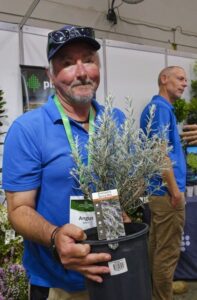
Eremophila nivea ‘Spring Mist’
‘Eremophilas are one of my favourite natives’, Angus Gault from Plantmark’s Vineyard site told me, ‘When they are in flower, they are stunning. Eremophila is one of those natives that not everyone knows about, whereas everyone knows grevilleas and banksias. They are tough plants. Eremophila nivea ‘Spring Mist’ makes nice informal hedging and fits well into a cottage garden scheme. The plant itself gives a good contrast. If you have got a lot of green in the garden, add this eremophila to put a little bit of silver in. It really makes everything pop.’
Angus also showed me the various coloured kangaroo paws Plantmark have available as we spoke about the use of native plants compared to traditional ornamentals, ‘People think you either need to have a native or an exotic garden. You can plant natives and exotics, and they look good together. People have got that old fashioned mentality where you must either have a native garden or your garden is full of roses.’ Indeed the Rhodanthe anthemoides ‘Southern Stars’ on display at the Plantmark stand would fit well within a naturalistic style planting or cottage garden. Angus told me this variety has been bred to be more compact and for its flowers to persist longer.
Kangaroo paws for every occasion
I also spoke with Jack Boyd, Angus’ Plantmark colleague, whose Christmas cheer had started early! ‘We have got a wide range of kangaroo paws, all different colours, Jack said, ‘For Christmas you can have the red and green cultivar, Anigozanthos ‘Bush Dance’. And if you like your footy (rugby), that variety is also South Sydney colours. If you want to go with the ‘Aussie’ theme, then check out ‘Bush Bonanza’, a green and gold variety. There is a kangaroo paw for any occasion.’
I was starting to think Jack had missed his calling as a marketer. However, as we continued our conversation, I realised that plants are his passion, especially natives.
Like Angus, Jack is a fan of eremophilas, which he says were used medicinally for respiratory issues and women’s health in Koori culture. ‘Another fantastic medicinal plant, something we are going to be stocking soon, is lemon-scented myrtle, Backhousia citriodora,’ said Jack which he says helps stop itching, ‘It works great as a drawing ointment as well. So, any splinters that you get, crush up some lemon-scented myrtle up on your splinter and it should be out within an hour or two.’
Great barrels of fire!
If there was a competition for best expo display, Exotic Nurseries & Landscaping may well have taken the medal home! ‘We always try to emphasise texture and foliage rather than flowers,’ business owner Paul Takchi told me, ‘We tend to do a lot more of the succulent and cactus range now, but we still do all your general lines as well, including ground covers, shrubs, trees, screening and hedging plants. We grow a lot of our own stock, everything from 140 ml up to advanced trees, whilst also sourcing stock to complete orders for landscape architects, designers and landscapers.’
Paul told me that Exotic Nurseries is releasing a new red version of the Golden Barrel Cactus (Echinocactus sp.) called ‘Fire Barrel’, ‘It works in with cactus gardens or you can incorporate it with general stock as well. We are finding a lot of people are mixing the cactus in with your general lines, so it is not a specific garden type.’
Angophora hispida (dwarf apple gum)
Charlotte Gutte, Sales and Marketing Manager, told me that Andreasens Green is getting ready for spring, ‘I am just wanting some more sun. Happy with the rain, yes, but the rain can happen overnight. We want sun during the day. It is looking like it will be a busy spring in terms of the different projects that we are working on. It is always our busiest time of year like it is for anyone in this industry, so we are just getting stock growing and getting it out.’ On display at the Andreasens Green stand were viburnums, nandinas, Eucalyptus sideroxylon, thryptomene and some Angophora hispida (dwarf apple gum), the latter which are very short on the market now according to Charlotte. This small, fast-growing, mallee-like tree grows to around six metres tall. Its numerous cream flowers in summer attract nectar feeding birds, bees, butterflies and other insects. Drought resistant and tolerant of coastal exposure, the dwarf apple gum is great for low maintenance gardens.
Anthurium ‘Pink Ruffles’
It seems like the enthusiasm for anthuriums that I saw on display at Greenlife Industry Queensland’s Green Expo on the Gold Coast in July will not be going away anytime soon. I spoke with Stephanie Carritt from Alpine Nurseries who told me about the Anthurium hookeri ‘Pink Ruffles’ that they were exhibiting, ‘It is just a big, beautiful anthurium. It grows huge, big and beautiful in the garden. It does not like to be really dark, but it is quite happy in the shade. It grows these large, lush leaves. We sell them in 300 ml pots. Because they are such a large grower, we figure that the 300 ml is the best size to sell them in.’ Anthurium ‘Pink Ruffles’ is a stunning plant with pink spathes, light bluish-purple spadices, and copper-toned foliage with reddish-pink venation.
This aroid was not the only plant at the Alpine Nurseries’ stand to capture the attention of event-goers, including myself. Whilst Casuarina ‘Green Wave’, Euphorbia ‘Silver Swan’, Helichrysum petiolare and Ligularia ‘Designer Verde’ all showed appeal, it was the large Cedrus deodara (Himalayan cedar) that Stephanie says got people talking. ‘They are slow growing, but they will become large,’ says Stephanie of this feature tree, ‘I would not put it in a small space!’
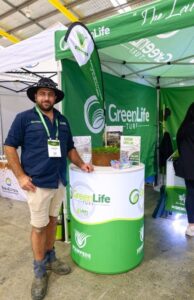
Talking turf
Various representatives of the turf industry spruiked the benefits of natural over artificial grass including Jenny Zadro from Turf New South Wales and the Sports Turf Association of New South Wales. I have interviewed Jenny previously but never had the pleasure to meet her in person. Meeting her like this reminded me of the benefits that events like this expo have in connecting industry professionals. For many of us, you get to meet people in person with whom you have only ever spoken with over the phone or online.
I also spoke with Mary Mifsud, Rivers Edge Turf, and Liz Stevenson, TurfBreed, about artificial versus natural grass. ‘Hopefully people can buy grass instead of going towards something that is artificial because it is better for the environment, and it keeps your house a lot cooler in summer,’ Mary said, ‘We want something that breathes, we want something that is good for the environment. Even if you put plastic in the ground, you still must maintain it. We have got enough plastic in our lives.’ Mary and Liz told me about the new IronCutter Hybrid Bermuda grass, essentially a couch, geared towards commercial projects, sporting fields and cricket wickets.
Meanwhile Joshua Muscat from Green Life Turf told me about another new release, ‘We have got a new and exciting Stampede Hybrid Buffalo which is going to be coming out in early 2026. It is a new hybrid buffalo that has been bred to have better performance than Sir Walter and other buffalo grasses out there. The Stampede is looking to have better lateral growth that runs around a lot quicker and tighter than other buffalos. It has a little bit less thatch than traditional buffalos and, probably its two biggest selling points, better winter colour and better disease resistance.’
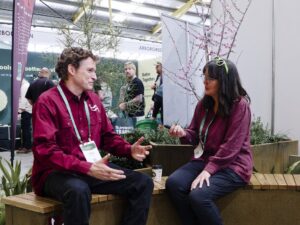
PRODUCTS
It would not be a ‘proper’ expo without products on display, and the Landscape Expo had plenty!
Hexagonal planter boxes
One product that grabbed my attention was the nifty little bench seat on display with storage underneath it at the ShapeScaper stand. ‘The bench seats are probably new for New South Wales. We have not really shown them here before,’ says Toby Lestrell, owner and head designer of Landscape Engineering Pty Ltd, the business behind the ShapeScaper brand.
The ShapeScaper team produce a range of steel garden edging and planter boxes already in use in the landscaping industry, including a series of modular hexagonal planters. These modular steel planters are manufactured in Australia using BlueScope Redcor weathering steel. The planter range is available in either a 500 mm or 700 mm profile with both profile heights featuring smooth rounded edges with a 40 mm x 20 mm return. ‘The hexagons are something I am passionate about. I really love the hexagon shape,’ says Toby. I have to say that I agree with Toby. These hexagonal planters provoked a biophilic response within me, given their form and repetition. Because they were placed immediately next to each other, they reminded me somewhat of the dolerite columns seen in natural phenomena such as the Organ Pipes west of Melbourne.
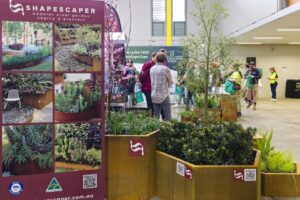
Coir logs
At the Fernland display, Nick Hutchinson showed me the coir logs that are just one of the 5,000 different products that this business sells. Nick says that these ‘logs’ are becoming big things in the landscape industry, ‘The coir logs will stop weeds coming through. However, they help the movement of the soil and keep the structure in place, which is key in a lot of big landscape jobs. They can be used on slopes, and they can help divert water runoff as well.’
Wicking systems
I also spoke with Ian Collins, CEO and founder of WaterUps, a company pioneering wicking systems for food growing and urban greening. Ian told me these systems are helping to tackle waste as they are made from recycled plastic, ‘We have now diverted nearly 400,000 kilos of plastic from landfill. All of this is post-industrial waste, single-source post-consumer recycled polypropylene that can be recycled again.’
Turning cartwheels
Mark D’Avolio from Ausreo showed me the new Carta measuring wheel that has recently arrived from the United States, ‘It removes the requirement of a tape measure. You can easily use the plot wheel to mark out the area that you need to measure, and it can work out the area squared, and the cubic meters required for a particular project. The wheel takes a couple of AA batteries, and it is simple to download the app and then off you go. The beauty of this measuring wheel is that once you take the measurement, you can export the map as a PDF, which then provides you with the measurements in square metres and the cubic metres. You can email that to a customer as a quote, and it gives you a full layout of what the area looks like and all the measurements as well.’
See you in 2026!
There was plenty more on display at the 2025 Landscape Expo. However, it took me nearly all day just to do the indoor circuit. I did do a quick whip around the outdoor exhibition area where permeable paving and large machinery were on display, and a programmed event space where eventgoers could learn from industry experts. But that is a wrap for me now. Hopefully I get to see you there next year!
